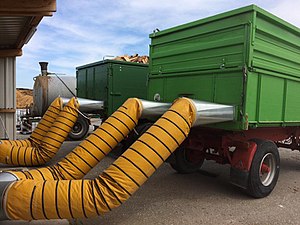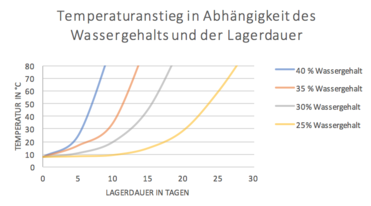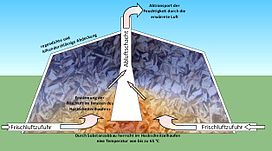Wood chip drying
Wood chip drying improves the shelf life and quality of wood chips . The lowering of the water content is achieved through self-drying, ventilation with cold or warm air or through additional movement during ventilation.
The water content that can be achieved through drying can be determined by the sorption isotherm and depends on the moisture content and the temperature of the ambient air as well as the drying time.
Reasons for drying
Storage Risks
Various chemical and biological degradation and conversion processes take place during the storage of moist wood chips. This can lead to substance degradation through fungal growth or other microbial processes, which is accompanied by a reduction in calorific value .
Fungal growth
During the storage of moist wood chips, fungal attack occurs depending on the storage conditions. Depending on the outside temperature, growth begins after about two weeks.
In the case of wood-decomposing fungi, a distinction is made between brown rot , white rot and soft rot fungi. The moisture of the wood, temperature and oxygen content have a decisive influence on the growth and reproduction of the fungi. Fungal growth is inhibited if the water content is below 20% and temperatures below 20 ° C. A higher water content of 30–50% and temperatures between 20 and 35 ° C, on the other hand, are ideal conditions for them.
The time of harvest, the size of the wood chips and the type and duration of intermediate storage also influence the severity of the infestation. If the wood chips are very moist and uncovered, the infestation is stronger than if the coarse wood chips are stored dry and covered. The exposure to fungal spores increases dramatically after several months of poor storage. Due to the high spore load, relocation or relocation processes can lead to health problems.
Substance degradation
Fungal growth and bacterial activity in the event of improper storage lead to the breakdown of combustible organic substances, which reduces the calorific value of the wood chips and increases the proportion of ash after they have been burned. In order to keep the loss of substance as low as possible, it is therefore of great importance to dry the wood chips before storage, as this slows down the breakdown of the substance. The storage period of moist wood chips should be kept as short as possible. In winter, when the microbial activity is low, moist wood chips with a small amount of bark have a tendency to freeze together, which can lead to clogging of the screw conveyor. With fine wood chips the dry matter losses due to substance degradation with natural drying are particularly high at around 15–30% per year, while with coarse wood chips with an edge length of more than 5 cm the losses are lower at 10–20% per year. To reduce the degradation of the substance, attention is paid to the lowest possible water content during storage and attempts are made to prevent renewed absorption of moisture without, however, impairing the supply of fresh air. This can be achieved, for example, by covering the wood chips with breathable fleeces.
| Water content | Storage time | Loss of dry matter | Loss per month | |
|---|---|---|---|---|
| Stored outdoors without a cover | 50-55% | 7 - 9 months | 20-23% | 2.9% |
| Dried, stored outdoors with cover | 15% | 7 - 9 months | 2% | 0.25% |
Relationship between calorific value and water content
During the drying process, water evaporates, reducing the mass of the woodchippings. At the same time, the specific calorific value and thus the energy density of the wood chips increase.
Calculation of the water content in percent by mass:
Water content [w / w%] =
Calculation of the wood moisture in%:
Wood moisture [%] =
Types of drying
Natural drying
Natural drying by convection has the advantage that this type of drying is very cost-effective and no additional energy is required.
In private forests, the wood is usually felled in winter and dries in wooden piles over the summer. For the next heating season, the wood, which has been predried to about 35 M / M%, is chopped. The wood chip drying can therefore be omitted. However, any existing bark beetle populations can multiply in the wood, which means that storage in the vicinity of the forest must be viewed critically. Later chopping can harm small animals that have settled in the piles of wood in the meantime.
Drying is very time-consuming and the substance degradation is 20 percent by mass per year of storage.
When drying wood chips, a distinction is made between the following methods:
First of all, the wood chips were stored in the open air as a pile of bulk materials. The drying takes place by natural convection and is additionally intensified by the self-heating in the bulk material heap. The wood chips self-drying is supported if the soil is air-permeable, which means that dry, cold air can flow into the pile from below. To do this, the wood chips are stored on a slotted or perforated surface. The temperature caused by self-heating can rise to 65 ° C during the first 30 days, depending on the outside temperature. The heat, which supports evaporation, reduces the water content from 40–50% to 20–35% within two months. To protect the wood from renewed moistening by rain, for example, it is recommended to cover the mountain of wood chips with a breathable fleece or to store the wood under a roof. The maximum height of the pile of about five meters must not be exceeded, otherwise the wood chips could spontaneously ignite due to the compression and the high internal heat.
The high fungal infestation and the resulting strong spore load represents a health risk if they can get into the lungs when the heap of wood chips is moved. The wood chips should be pre-dried accordingly, as fungal growth is inhibited if the water content is below 30%.
Another natural drying method is floor drying in thin layers. The wood chips are distributed in a flat layer on a large, dry and clean surface. The sun dries the wood within a few days. To support the effect, the wood chips should be mixed at least once. This process requires a lot of space and is therefore not suitable for drying large quantities of wood chips, and you have to rely on a dry and sunny climate for several days.
Technical drying
General advantages of technical drying are the low dry matter losses and the fast drying within a few hours or days, depending on the amount of wood chips and the method used. The increase in the calorific value is highest with a drying method with cold or warm air ventilation, whereby the additional energy expenditure with warm air ventilation must be taken into account.
The drying principle is the same for all technical drying systems. Dry air is blown through the wood chips, whereby the water bound in the wood is absorbed and transported away. An optimal fan design is very important for efficient operation, since an oversized fan has an unnecessarily high energy consumption. This increases costs and efficiency suffers.
The ventilation resistance (specific air resistance ∆p in Pa / m) is decisive for a correct fan design. This describes the flow resistance that the air has to overcome when penetrating the HS. It depends on the nature of the wood chips, the thickness of the wood chip layer and the speed at which the air should penetrate through the wood chips. It is calculated with functions according to RAMSIN, SHEDD or HUKILL & IVES, ERGUN. The ventilation resistance offers a rough approach for the dimensioning, since the exact parameters for the calculation are difficult to determine.
The optimal air throughput for lying bulk goods is 180 - 540 m³ / h per m² of floor space, which corresponds to an air speed of 0.05 - 0.15 m / s. The minimum required fan output is calculated on this basis. If the speed is too high, fine particles are blown out at the same time; if the speed is too low, the drying effect is too poor.
Technical drying systems
Drying systems without material conveyance
Batch dryer
With this type of drying, air flows from below through ventilation pipes or double floors made of grids or perforated floors through the wood chips. This optimizes the ventilation conditions. The wood chips are dried in batches in batches. The thermal efficiency is around 40%.
One advantage of batch drying is that the process is inexpensive and the wood chips can be transported in the dryer, for example in a container.
The disadvantage is that the arrangement of the wood chips when they are poured into the dryer means that different drying processes take place during the drying process, since the wood chips are not searched. This reduces the efficiency of the system and the drying homogeneity.
Batch dryers are a useful addition to biogas plants in order to use the waste heat in the summer months. For drying animal feed or food, for example, batch dryers cannot be used efficiently because the throughput and the degree of heat utilization are too low.
Drying systems with material conveyance
This is a moving drying process, also known as continuous drying . The wood chips run continuously through the dryer and are dried quickly and homogeneously by a high mass flow of hot air. Investment, operation and maintenance are, however, more complex than with drying systems without material conveyance. The dryers used are, for example, push-and-turn dryers, belt dryers and drum / or rotary kiln dryers.
Push and turn dryer
Similar to the batch dryer, the push-and-turn dryer has a grid or perforated floor. During the drying time, the wood chips travel several times over the entire drying length and are mixed with an agitator shaft.
This type of dryer has a low energy requirement and works efficiently.
The area required by the system is relatively high, and the mixing can cause dust to be raised, which makes exhaust air cleaning necessary.
Belt dryer
In the case of a belt dryer , the wood chips are conveyed by an air-permeable belt and, in the meantime, dried by warm air flowing through the belt. The belt speed and the humidity can be regulated separately in order to adjust the system to different materials and qualities.
Due to the low drying temperature of 75–110 ° C, the energy consumption is low, since waste heat can be used, for example.
Because of the constant bulk height, drying is usually not completely even.
Drum / rotary tube dryer
In this process, the wood chips are passed through a slightly inclined drum.
This type of dryer has a high drying capacity and is also compact. Due to the high temperatures, which require additional energy, a homogeneous drying takes place.
Integration in a heating (power) plant
Upstream
Some systems, such as small wood chip heating power stations or wood gasifiers, need a consistently high wood chip quality. It is therefore necessary to dry the wood chips before they can be used to generate energy. Either pre-dried wood chips are bought in, or drying takes place on site.
Downstream
If you consider technical drying systems on a purely energetic basis, more and more energy has to be used for drying than the wood chips gain in additional energy content. Therefore, it only makes sense to use waste heat that is already generated. Wood chips offer the advantage that they do not have to be processed or dried within a certain, short time window like other drying goods (e.g. grain). They can also be pre-dried or stored naturally at first without any significant loss of quality.
For example, when using waste heat from biogas plants (especially in accordance with EEG 2012), the waste heat from the block-type thermal power station can be used for drying, especially in summer when hardly any heat is needed. This improves the utilization and thus the profitability of the biogas plant. About 38% of the operators use the waste heat for drying processes. The use of waste heat is promoted in biogas plants that run under the EEG 2009 as part of the CHP bonus according to §27 Renewable Energy Sources Act 2009 in the amount of 3 ct / kWh. Since the EEG 2012, the generation of 60% CHP electricity has been mandatory for biogas plant operators and is no longer paid for separately. In the case of biomass (H) KWs, almost 30% of the systems use the heat generated to dry the wood; in the case of wood gasification systems, around 21% (multiple answers were possible). [Note: wood in general and not specifically HS!]
Financial funding opportunities
The KFW grant 271 (Renewable Energies - Premium) subsidizes investments in the upstream drying in connection with a biomass combustion plant.
Biomass combustion systems are funded both for purely thermal use and in combination with electricity generation (combined heat and power systems) with a nominal heat output of more than 100 kW. Only solid biomass such as wood pellets, wood chips or split logs may be burned, no waste. Specified emission limit values must be observed.
Individual evidence
- ↑ a b c d e f g h i Martin Kaltsschmitt: Energy from Biomass - Basis, Techniques, Processes . 3. Edition. Springer Verlag, Heidelberg 2016, ISBN 978-3-540-85095-3 .
- ↑ a b c d e f Andreas Neff: Processing of energy wood chips - with special consideration of the quality parameters. Dissertation to obtain a doctorate . Sierke Verlag, Göttingen 2007.
- ↑ a b c d Thomas Hering: Guideline for the efficient and environmentally friendly production of energy wood . Ed .: et al. 4th edition. Thuringian State Institute for Agriculture, Jena 2013.
- ↑ a b c d e Daniel Kupitz: Ventilation resistance in technical wood chips drying. in: Reports from the TFZ 40- Optimal preparation methods for wood chips . Straubing and Freising-Weihenstephan 2015.
- ^ Carmen report. (PDF) (No longer available online.) Archived from the original on September 17, 2017 ; accessed on May 20, 2017 . Info: The archive link was inserted automatically and has not yet been checked. Please check the original and archive link according to the instructions and then remove this notice.
- ^ Mechanical engineering TU Dresden. (PDF) Retrieved May 19, 2017 .
- ↑ InnoDry final report. (PDF) Retrieved May 31, 2017 .
- ↑ kfw.de. Retrieved May 8, 2017 .
- ↑ Funding programs for domestic funding. (PDF) Retrieved May 8, 2017 .









